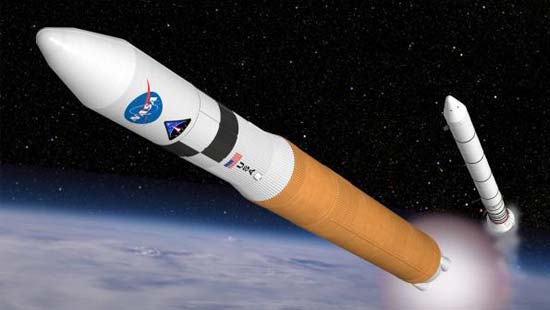NASA Says New Heavy-Lift Rocket Needs More Funding and Time

WASHINGTON — NASA told U.S. lawmakers Monday (Jan. 10) it intends to build a heavy-lift rocket that incorporates the space shuttle’s main engines, giant external tank and taller versions of the solid-rocket boosters it jettisons on the way to orbit, according to a senior NASA official. But neither the rocket nor the crew vehicle it would launch can be completed within the cost and schedule Congress outlined for the project late last year.
Congress directed NASA last fall to get started this year on a multipurpose crew exploration vehicle and a heavy-lift rocket initially capable of hauling 70 to 100 metric tons of payload to orbit. That guidance was included in the NASA Authorization Act of 2010, which President Barack Obama signed into law in October. The law gave NASA 90 days from enactment to produce a heavy-lift launch vehicle study.
Doug Cooke, NASA associate administrator for exploration systems, said the agency recently concluded the best approach for meeting the heavy-lift requirements spelled out in the law will be to build a rocket that incorporates the shuttle's nearly 8.4-meter diameter external tanks, five space shuttle main engines also known as the RS-25D, a J-2X-based upper stage and two five-segment solid-rocket boosters similar to those NASA and industry have been working on the past several years for the Ares family of launchers Obama targeted for termination in the 2011 budget blueprint he sent lawmakers last February.
Cooke outlined the agency’s baseline heavy-lift rocket design during a presentation to the NASA Advisory Council’s exploration subcommittee here Tuesday (Jan. 11).
According to a Jan. 10 interim report to Congress detailing the proposed space transportation system, the rocket and crew vehicle designs the agency has selected respond to congressional direction to make wide use of existing space shuttle infrastructure and minimize the costly termination of hardware contracts the agency awarded under the moon-bound Constellation program the Obama administration has marked for cancellation.
“This design would allow NASA to use existing Shuttle main engine and booster component assets in the near term, with the opportunity for upgrades and/or competition downstream for eventual upgrades in designs needed for production of engines after flying out the current inventory of main engines and booster components,” states the 22-page document, a copy of which was obtained by Space News.
“However, to be clear, neither Reference Vehicle Design currently fits the projected budget profiles nor schedule goals outlined in the Authorization Act,” the document states.
Get the Space.com Newsletter
Breaking space news, the latest updates on rocket launches, skywatching events and more!
The 2010 NASA Authorization Act gives NASA until 2016 to field the heavy-lift rocket and crew vehicle and authorizes more than $10 billion in spending on the two projects over the next three years.
Cooke said NASA expects to deliver a final report to Congress in the spring pending the results of a slew of heavy-lift launch vehicle study contracts awarded to 13 U.S. companies in November that are expected to yield a gamut of launch vehicle design proposals.
Cooke told Space News the studies would be used to validate the design proposal delivered to Congress Jan. 10 and to evaluate whether another option is worth considering.
“And if there is then we should reconsider,” he said following his presentation to the NASA Advisory Council’s exploration subcommittee. “If it’s marginally different, and we lost a benefit, even if it’s not cost, I’m not sure we would change it. But if there were a dramatic difference we should obviously consider it.”
This article was provided by Space News, dedicated to covering all aspects of the space industry.
Join our Space Forums to keep talking space on the latest missions, night sky and more! And if you have a news tip, correction or comment, let us know at: community@space.com.
Amy Svitak is a writer for Space Intel Report, covering the global space industry. Her older work can also be found in Aviation Week & Space Technology, where she covered European space and defense news, as well as in Space News, where her articles tracked the development of regulations on the up-and-coming commercial space sector, among other topics.










